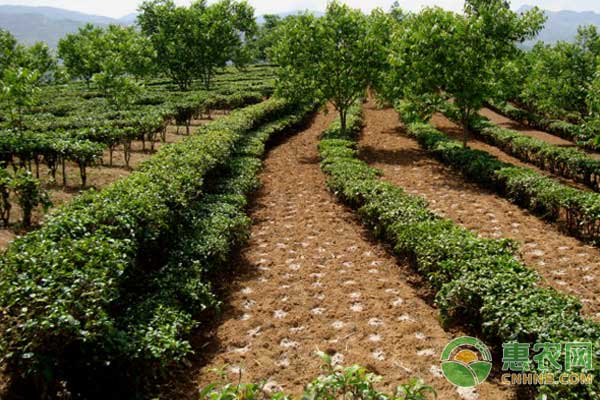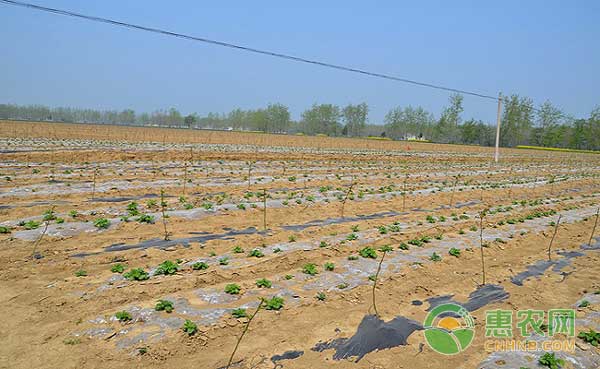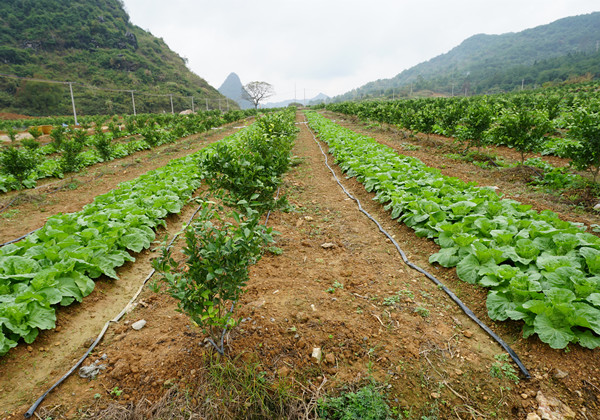Crops also have close friends and family members.
Interplanting is a common method of planting, which can improve land use efficiency and increase planting efficiency. However, different crop intercropping is also very particular. Some crops belong to complementary confidants, while others belong to the head-to-head type. These two crops are not suitable for interplanting. Let's introduce the close-up crops and the crops of the family!

First, close friend crops
1. Corn and soybeans are a close friend. Corn likes to eat nitrogen fertilizer. Soybeans produce nitrogen fertilizer through root nodules. Except for a small part of their own use, most of them supply corn unselfishly, and corn can secrete higher carbohydrates to provide nutrients for the rhizobium needed by soybeans.
2, vegetable farmers single kind of vegetables, often the pests occur heavier, if you can grow some garlic, onions, leeks, peppers and other irritating vegetables, then the pests are not willing to approach. Onions are adjacent to wheat or peas, and the onion secretions put the black smut of wheat smut spores or peas to death in a matter of seconds. Onions are like green doctors, able to protect their neighbors from being safe and healthy.
3. Garlic and cotton are planted together with garlic to evaporate a bactericidal agent that can drive the mites out of the country. Other pests will smell the wind and escape.
4, plant a few nettles in the soybean field, can make the chafer escape.
5. Planting a sorghum between 1.5-2 meters on both sides of the cotton ditch, then the high locusts can induce the mites, spiders, ladybugs, scorpion flies and other natural enemies to control the cotton aphid. The cotton bollworm eggs and young larvae, while 200-300 sorghum or corn per 700 square meters, do not affect cotton production, but also prevent cotton from falling due to wind and rain.
6, potato and barley intercropping can make high yields of barley. This is not only because they need different nutrients, they can make full use of the ground force, but also because the leaves of the potato secrete a substance that can promote the growth of barley like growth hormone.
7. Make 300-400 lettuce and mint per acre in cabbage and other cruciferous vegetable fields. Because lettuce and mint contain alkaloids, volatile oil or other chemicals. The cabbage butterfly that harms cruciferous vegetables is avoided by the scent of lettuce and mint.
8. Planting green manure, beans, peanuts, etc. in the orchard can not only control weeds in fertile soil, but also promote fruit tree growth and results.
9. Planting wheat under jujube trees, jujube trees are basically not shaded by wheat, and can also reduce the threat of dry hot wind before ripening of wheat. At the same time, the fertilizer and water of wheat are also beneficial to the growth of jujube trees.
10. If the nematode is seriously damaged, the hors d'oeuvre or asparagus can be planted in the garden, so that the underground fruit tree nematodes will not be fertile.
11. Plant some golden lotuses next to pear trees and apple trees. Since these roots can absorb the secretions of the golden lotus roots, the occurrence of pests and diseases is also light.
12. Cherry and apple are born together. If they are planted together, they can release a volatile gas and absorb each other to promote growth and development. The fruit is particularly sweet.
13. Hedgehog and poplar are "friends". Hedgehog is a shallow-rooted tree species. Poplar is a deep-rooted tree species that does not compete for water and fertilizer, and the rhizobium of the hedgehog can supply nitrogen to the poplar to promote its growth.
14. If cucumbers and beans are planted together, they will show a huge increase in their vitality.
15, corn intercropping cabbage can reduce a variety of diseases of cabbage. Maize intercropped cabbage field, because the field temperature is 0.5 °C lower than that of single field, and the ground temperature drops by 2 °C, which can reduce cabbage virus disease by more than 20%, leukoplakia by 18%, cabbage soft rot and downy mildew. .
16, corn and spicy (green) pepper intercropping can reduce the spicy (green) pepper disease. Because of the shading effect of corn, the sunburn and viral diseases of peppers are reduced by 72% compared with single cropping; the intercropping of corn and green pepper can reduce the green pepper virus disease by 56.9%.
17, corn and pea mixed together will benefit each other, both increased production.
18, potato and garlic intercropping can inhibit the occurrence of potato late blight.
19. Planting cucumber between corn can reduce the onset of cucumber virus disease. Planting cucumbers in corn rows can reduce cucumber mosaic disease by 61.6%.
20, in the greenhouse between ginger and bitter gourd intercropping early ginger can be listed, ginger is not resistant to high temperatures, not glare, good growth in the shade, planting ginger in the greenhouse, planting bitter gourd on both sides can make both bitter gourd and ginger harvest .
21, under the cucumber shed, the cabbage, celery and leeks can all be harvested.
22, the eggplant between the green onions and leeks to control ants.
23, greenhouse pepper and cucumber intercropping, effective control of pepper anthracnose and cucumber downy mildew.
24, Chinese cabbage and other cruciferous vegetables and lettuce intercropping to avoid cabbage caterpillars.
25. Intercropping between Chinese cabbage and Chinese cabbage to control soft rot of Chinese cabbage.

26, tomato and cabbage intercropping to avoid cabbage pests.
27. Calendula is planted together with the rose, which can effectively control soil nematodes and make the rose thrive.
28. Grapes are mixed with violets, and the resulting grapes are more fragrant.
29, peony and peony intercropping, can significantly promote the growth of peony, make the peony branches flourish, flowers and colorful.
30. Red sapwood and maple, elder and spruce, walnut and hawthorn, chestnut and pine can promote each other.
31. Lilies and roses are planted or bottled together to extend the flowering period.
32. Camellia, tea plum, safflower oil tea, etc., together with the mountain tea, can significantly reduce the mildew.
33, Zhu Dinghong and Ye Laixiang, Camellia red onion, pomegranate and sun flower, Ze Hydrangea and rose, a string of red and pea flowers together, both sides are beneficial. Pine, poplar and caragana together have a good effect.
34. Flowering only one day of nasturtium is placed together with cypress trees, and the flowering period can be extended to 3 days.
35, camellia, tea plum, safflower oil tea, etc., together with the mountain scorpion, can significantly reduce mildew disease.
36. Onions and carrots are good friends, and the odor they emit can evict pests from each other.
Second, family crops
1. The secretion of hedgehog and clove has an inhibitory effect on the growth of adjacent flowers and trees, and cloves and violets cannot be mixed.
2. The leaves and roots of walnuts can secrete a substance that inhibits rose flowers and various herbaceous flowers such as sea bream.
3. It is not advisable to plant cedar trees around the peach trees.
4, grapes can not be planted with the small leafhopper.
5. Eucalyptus cannot be planted with eucalyptus or white birch.
6, pine and spruce can not be planted.
7. The secretion of elder roots inhibits the growth of pine and poplar.
8, a variety of flowers planted next to the fruit trees, will accelerate the loss of flowers.
9, Narcissus and Lily of the Valley are thought to be neighbors, and when they are together, they will "go to the same end."
10. Cloves are planted next to the lily of the valley and will immediately languish.
11, the fragrance of cloves will also endanger the life of the daffodils.
12. Bring cloves, violets, tulips, and forget-me-nots together, and each other will suffer.
13, pepper, rose and other flowers that can secrete aromatic substances, have a certain inhibitory effect on the ecology of the adjacent flowers.
14, cypresses and pears, sea otters do not plant together, so as to avoid the latter suffering from rust, leading to deciduous fruit.
15. Roses and sylvestris together, the former crowded the latter, so that the whole fades; and the sylvestris will release a chemical substance before and after the loss, causing the death of rose poisoning.
16. Mature apples, bananas, etc., if placed together with the open rose, rose, narcissus, etc., the former releases the ethylene, which will make the potted flowers thank you earlier, thus shortening the viewing period.
17. The leaves, skin and roots of oleander secrete bamboo stalks and walnut stalks, which will damage other flowers.
18, Hydrangea and jasmine, dahlia and rose, narcissus and lily of the valley, rose and cloves together, will cause damage to both or one of them. Pine trees can't coexist with elderberry. It not only strongly inhibits the growth of pine trees, but also makes the pine nuts under the elders unable to germinate. It can not crowd the growth of white leaves. Pine trees have a confrontational relationship with white wax, spruce, eucalyptus and white birch. The result is that the pine trees are wilting. Cypress and orange trees are also not easy to grow.
19, clove, mint, laurel can secrete a lot of aromatic substances, inhibiting the ecology of neighboring plants, it is best not to place a piece of potted plants for a long time; volatile oils of cypress, containing ether and trichlorotetrazane It will slow down the breathing of other flower plants, stop growing, and be poisoned.
20, cabbage and mustard is a pair of "enemy", if you get along, you will lose both.
21. Chemical substances secreted by cannabis, mustard, and flax have obvious inhibitory effects on post-production wheat.
22, sunflowers, tomatoes, apples, pumpkins will promote the occurrence of potato late blight.

23, the cypress trees next to the grapes, the grapes are difficult to mature.
24. Mustard and ramie are planted together. Although ramie is taller and thicker than mustard, it has an advantage in terms of competition for sunlight, air and moisture. However, the leaves in the lower part of ramie are always dead. The reason is that the secretion of mustard is harmful to ramie. Growth.
25, the field grows the weeds of borage, the surrounding crops, and even high-stalk crops such as corn and sorghum are yellow. This is because the roots of the bitter vegetable secrete an anesthetic toxin that inhibits the killing of the crop.
26, the impact of this kind of relationship between crops, not only in the common growth period of the year, and some left behind sequelae, continue to harm the crops. Quinoa is the same for corn. In the fields where buckwheat is grown, corn is grown. Although it is well-fed and well-managed, corn is always bad, and it is not high-yield.
The substances that determine the relationship between the crops are the volatile oils, organic acids and alkaloids secreted in the body, and the other crops may play a role in promoting growth or antagonism. Therefore, growers need to understand this role and scientifically arrange for planting to achieve high yields.
Neckbandhearing Aid,Neckband Hearing Headphones,Neckband Hearing Headsets
Neckbandhearing Aid,Neckband Hearing Headphones,Neckband Hearing Headsets
Shenzhen Sunshine Technology Co.,Ltd , https://www.shenzhenyatwin.com